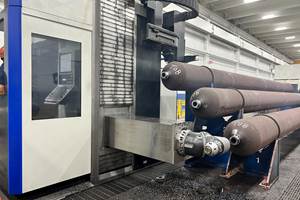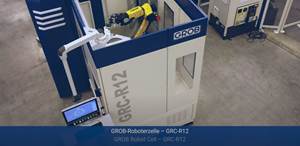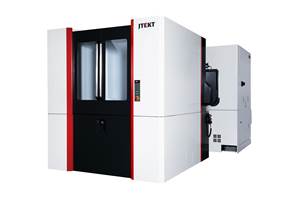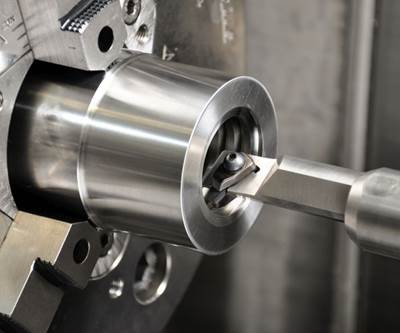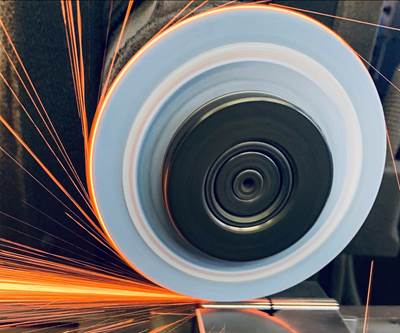How One Job Shop Tackled Tungsten
When this aerospace job shop settled on machining tungsten alloys and other heavy metals as its specialty, it had to have a machine tool, cutting tools, workholding and process know-how to succeed.
Share




With density comparable to gold and uranium and almost twice that of lead, tungsten is a stellar choice for use in counterweights and ballast, as well as radiation shielding, ballistic penetrators, vibration-damped tooling, and sporting goods such as golf clubs. Many applications that exploit tungsten’s singular qualities are in the aerospace industry, where compact, precisely positioned concentrations of mass contribute to aircraft stability and smooth operation of flight controls and engines. The parts are typically alloys formed from powders of tungsten, nickel and iron and then sintered. These tough, stable, abrasive alloys can present machining challenges.
These are precisely the challenges that Alro Machine Company thrives on.
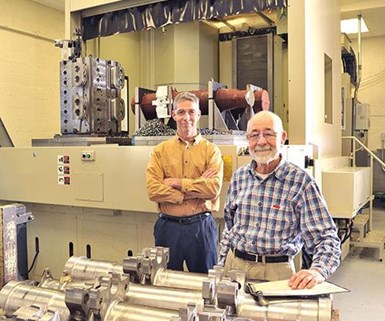
Steve Young, president of Alro Machine Company (left) and his father, company founder Ron, look over large, tough-to-machine aerospace components that are the company’s specialty.
Alro, a manufacturer of machined and assembled parts for the aerospace industry, was founded in 1960 in Lindenhurst, Long Island, as a screw machine shop. It has evolved and grown to become a supplier of parts and services for both fixed-wing and rotary aircraft. It also provides machining to support maintenance and repair of components and assemblies. At the time of this writing, Ron Young, the company founder, was 81 years old and still working in the shop daily with his son Steve, company president.
Steve Young says Alro Machine made a conscious decision to focus on machining hard and heavy metals. The shop did not have the capacity to maintain both aluminum and heavy-metal machining capability. “So we just had to pick one and go with it, and we picked the heavy metal business,” Mr. Young says.
Today the shop machines hardened steel, tungsten and titanium for an assortment of aerospace parts. “We’ve cut tungsten for Lockheed-Martin; the parts are called ballast, and the company uses them as counterweights to balance the aircraft. We’ve also made tungsten parts for helicopter rotor heads,” Mr. Young says.
Making a go of machining heavy metals as a specialty was not a decision taken lightly, however. It dictated the choice of every major factor in the machining process. To machine tungsten alloys, for example, the company needed a machining center with exceptional rigidity and high torque at low spindle speeds. Indexable inserts and other cutting tools had to have exceptionally sharp cutting edges. Workholding fixtures needed to have vibration resistance and repeatability, and quick-change capability was a definite plus.
Of these choices, however, the most important to consolidating its commitment to heavy metal machining was acquiring a HMC specifically suited to this task. This machine, a Mitsui Seiki HU-100A, was chosen for rigidity, high torque at low spindle speeds, high-pressure coolant delivery and other features. Delivered in 2012, it marked a decisive turning point for Alro Machine.
Success with tungsten also brought out another essential factor: Alro’s deep instincts as a job shop. These include being creative yet practical in problem solving, being versatile without loosing focus, and being committed to and rewarded by simply getting each job done right.
How Does Tungsten Like To Be Cut?
Tungsten is generally considered to have machinability similar to gray cast iron because it produces short chips and is abrasive. However, according to ATI, a provider of Densalloy heavy tungsten alloys, materials with lower percentages of tungsten are more ductile than high-percentage compositions and tend to share the machining characteristics of stainless steels of comparable hardness. With high elastic stiffness, tungsten alloys require greater cutting forces than typical for most metals, so rigid tooling and adequate spindle torque are essential for effective machining. Some low-percentage tungsten alloys are ductile to the point that they produce continuous chips when machined, thus requiring adequate chip control.
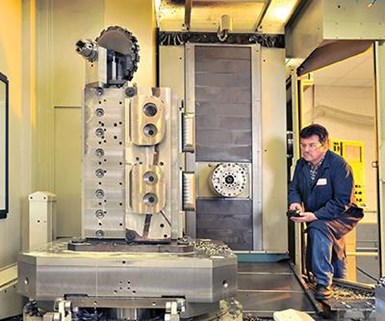
Shop foreman Walter Dzikowski checks the workholding tombstone, which features an in-house-designed and fabricated tool mounting station for a 50-lb custom milling tool.
Shop foreman Walter Dzikowski confirms this assessment of tungsten. “We’re using tungsten that is 97% pure, and it’s very tough. It is much tougher to cut than titanium; I could cut titanium all day long, but I would like to stay away from tungsten. You can cut steel much faster and you can push it, but tungsten you cannot. You have to give it time to cut.” Tungsten’s abrasiveness and the heat generated in high speed, heavy feed machining wears tools quickly, he adds.
Mr. Dzikowski says a key contributor to successful machining of tungsten is vibration control. “The first thing is the setup — how we hold the part. We cannot allow the part to vibrate because tungsten is so hard and dense. If there is vibration, your tools will chip.” Similarly, the machine tool used to cut tungsten must be rigid and resistant to vibration, he notes.
Tool choice is equally important. “I find you need a high-positive cutting edge and the right carbide grade and coating,” Mr. Dzikowski says. “Because of the high density of this workpiece material, you need to shear it. You have to keep the tools sharp; a dull tool just pushes the material away.” The shop employs mostly Kennametal and Sandvik tooling, and it relies on those suppliers’ application experts to suggest cutting parameters for specific tungsten alloys.
Coolant is also an important consideration for tungsten machining. Mr. Dzikowski believes that the best coolant for tungsten would be sulfur oil. However, he explains that it would be impractical to switch out a tank with 2,000 liters of coolant, especially on a machine used to cut a variety of materials. As a result, Alro Machine enriches its coolant to 20% oil to water, a ratio that Mr. Dzikowski finds beneficial to tool life.
Fixturing for Rotor Part
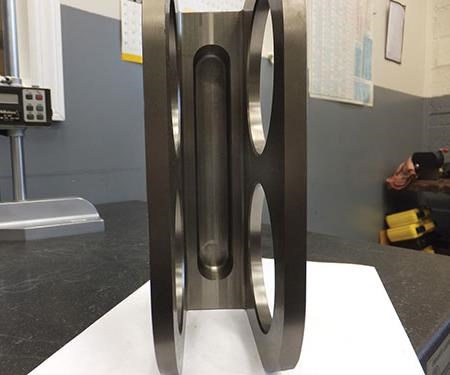
This tungsten alloy weight is a component of the main rotor head of a helicopter. Alro Machine uses the special milling tool to machine the bottom of the central cavity in a single pass. Milling the pocket in at the back of the interior with an extended finishing tool is a test of the vibration resistance in the machine, the tool assembly and the fixturing.
A typically challenging tungsten job involves machining a weight for the main rotor head of a helicopter. This workpiece measures roughly 9 by 6.5 by 2.7 inches and consists of a high-percentage tungsten alloy. The shop has substantial experience with this type of workpiece. It recently completed 280 pieces in lots of 50 or 60.
Much of the part is hollow, with a pocket at the back of the interior that requires a finishing tool to reach about 6 inches. Because of the depth, this operation is especially susceptible to the tool chipping caused by vibration. “We’re using a Kennametal modular tool with a 1-inch-diameter replaceable cutter that’s threaded into on a carbide shank,” Mr. Dzikowski says. To increase stiffness and minimize vibration, the shop mounts the shank in an HSK shrink-fit holder.
Alro Machine addressed part-holding rigidity and repeatability by engineering a massive, custom-made tombstone that holds two parts on two sides. The tombstone is fitted with a Jergens fixturing system. Each workpiece bolts to a plate that has a bushing that clamps into a mating receiver on the tombstone. A pin with expandable balls on the end inserts through the bushing to align the workpiece accurately. Mr. Dzikowski reports that the fixturing system aligns parts repeatably to ±0.001 inch. This fixture enables workpieces to be loaded and unloaded rapidly to reduce setup time.
Custom Tooling
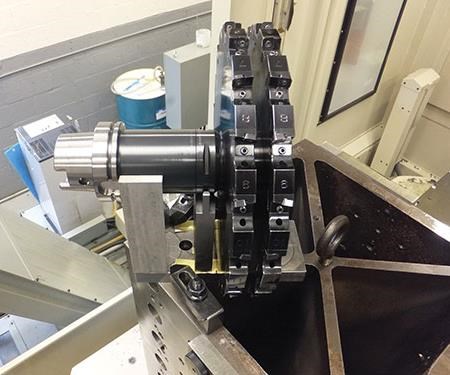
This tool, shown in the mounting station atop the workholding pedestal, has twin slotting cutters that are 13 inches in diameter.
The shop mills the deep central slot of the tungsten weight with a custom-made Kennametal tool consisting of two parallel slotting cutters mounted on a single HSK 100 shank. Assembled, the tool measures 13 inches in diameter — too large to fit in a machine’s toolchanger magazine. “We came up with the idea of putting a mounting station for the cutter on top of the tombstone,” Mr. Dzikowski says. To use this cutter, the machine is programmed to rotate the tombstone into position and (after air and water flush chips from the tool) maneuver the spindle opening onto the exposed toolholder taper. When the operation is complete, the machine replaces the tool in the mounting station. Previously, the 50-lb cutter had to be loaded and unloaded manually, a task for two people. This type of problem solving is characteristic of Alro Machine’s job-shop thinking.
This custom-designed cutter machines the bottom of the slot between the two sides of the part. “At one point the full width of the cutter engages the bottom, so it needs a lot of torque to drive through the tungsten,” Mr. Dzikowski says.
Hard Metal Machine
Initially, Alro Machine used this cutter on a horizontal machine that didn’t have adequate torque at low spindle speeds, Mr. Dzikowski recalls. While running the cutter at 250 sfm, a speed necessary to generate sufficient power to make the cut, this machine required two roughing and two finishing passes to complete the slot.
“It couldn’t be done in one pass because when the cutter hit the bottom of the slot, the combined width of each pair of inserts in full engagement with the workpiece was just too much for the machine,” Mr. Dzikowski explains. The relatively fast cutting speed accelerated tool wear, requiring frequent insert replacement. It also resulted in chatter. In addition, Mr. Dzikowski says, the cutting speed created excessive heat that often caused the sides of the part to warp out of parallel.
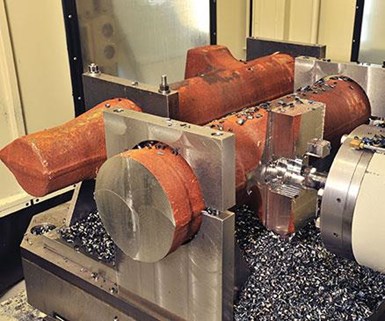
Landing gear components of high-strength 300M steel are among the large, complex workpieces produced on the shop’s Mitsui-Seiki HU-100A HMC. The machine’s Z-thrust and torque capabilities enable the shop to drill precision holes as large as 4-inches in diameter in the workpieces.
Faced with these limitations, Alro Machine decided to look for a machine tool that could handle tungsten machining as well as other heavy operations. The shop’s research showed that torque was dominant issue. For this reason, the shop acquired the Mitsui Seiki HU-100A. Designed for processing heavy metals and hard workpiece materials, this four-axis HMC has a 6,000-rpm spindle that produces 1,990 foot-pounds of torque at a continuous 106 rpm. Weighing 70,000 lbs, the machine is constructed with square steel boxways and occupies a 26-by19-foot space on the shop floor. The spindle holds HSK 100-taper toolholders. X, Y, and Z travels are 51.2, 47.24, and 39.4 inches, respectively. For stability and vibration control, the machine is installed on a 3-foot-thick concrete foundation.
One Pass Instead Of Four
Alro Machine now mills the slot in the tungsten helicopter weight in a single pass at 102 sfm (30 rpm) on the Mitsui HMC. “We are able to run the same feed as the other horizontal, but at much lower rpm, while still generating sufficient torque,” Mr. Dzikowski says. With less-stressful machining parameters, the sides of the part remain parallel, unaffected by excessive heat. The slower cutting speeds also reduce the effect of tungsten’s abrasiveness, increasing insert life, Mr. Dzikowski says. “We save about 30 percent on the cost of inserts with the new machine,” he adds. Cycle time savings for the slot milling operation is about 40 percent lower, despite the slower cutting speeds, because the slot is completed in one pass instead of four.
With a standing order for these tungsten weights, the shop usually processes them in lots of 50 or so pieces. Completing all four workpieces mounted on the tombstone takes 16 hours. The long cycle time prompted the shop to run the job unattended. Extended tool life at a lower spindle speed enables one set of inserts to last the entire cutting cycle. “When we let this go overnight, we just hit cycle start and go home. In the morning, we have four good pieces,” Mr. Dzikowski says.
Manufacturing Is a Way of Life
Taking on the challenges of machining difficult materials is more than a business strategy, Mr. Young says. It’s a way of life, he contends, one that is sustained by a combination of motives, including family tradition. “My dad started the company 53 years ago, and he is here every day. Many shops our size are gone now,” he says. Another motive is a sense of patriotism. “You don’t want manufacturing to be something that the United States used to do. I think we should still be able to do it here.” Finally, there is a matter of pride. “It’s the challenging stuff we want to keep doing. There’s the sense of getting something done and done well. I guess that’s why we are still here,” he concludes.
Related Content
Large-Format Machining Simplifies Tube Manufacturing
Downtime is the enemy of efficient manufacturing — a problem FIBA Technologies has addressed through purchasing a Soraluce FLP 14000.
Read MoreFour-Axis Horizontal Machining Doubles Shop’s Productivity
Horizontal four-axis machining enabled McKenzie CNC to cut operations and cycle times for its high-mix, high-repeat work — more than doubling its throughput.
Read MoreGrob Robot Cell Enables Long Periods of Unmanned Operation
The GRC-R12 robot cell features a pneumatic single- or double-gripper system, as well as a drawer feed system with six drawers.
Read MoreJTEKT Launches New Series of HMCs
The new FH5000 series machines include a 500-mm table capable of handling 1,000-kg loads.
Read MoreRead Next
Threading Options for Hard Materials
Here are three approaches to threading hardened components.
Read MoreRotary Broaching: Making Hard Materials Look Easy
Rotary broaches manufactured with a proprietary hardening process can cut material as hard as 50 HRC with minimal tool wear, improving the production process for medical screws and other components.
Read More7 Tips for Programming Ceramic Cutting Tools
Ceramic tools require different thinking and a willingness to tweak tool paths developed with carbide in mind.
Read More
























